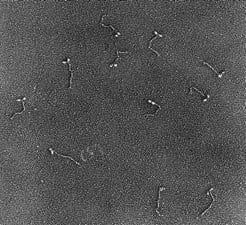Metal Shadowing

Rotary shadowed myosin molecules.Photo Craig Lab
Metal shadowing of bacteria, viruses, isolated molecules, and macromolecular assemblies is another high resolution method for observing the ultrastructure of biological specimens. A heavy metal is evaporated from a source at an oblique angle to the specimen. The metal atoms pile up on the surfaces that face the source, but the surfaces away from the source are shielded and receive little metal deposit, creating a ‘shadow’. A variation on this basic technique is to rotate the specimen during the metal deposition, rendering a high resolution three-dimensional replica of the specimen.